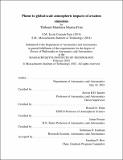Plume to global-scale atmospheric impacts of aviation emissions
Author(s)
Fritz, Thibaud Matthieu Martin
DownloadThesis PDF (13.73Mb)
Advisor
Barrett, Steven R.H.
Terms of use
Metadata
Show full item recordAbstract
Commercial aircraft combustion emissions impact the atmospheric composition, alter the Earth’s climate by accounting for ~4% of anthropogenic radiative forcing [72, 49] and affect surface air quality, causing an estimated ~16,000 premature mortalities per year [7, 28]. These environmental impacts are driven by chemical, microphysical and transport processes that span different magnitudes of temporal and spatial scales, from near-field inplume chemistry that evolve over minutes and distances of ~100 m to global-scale phenomena taking place at the continental scale. To evaluate aviation’s environmental impacts, all temporal and spatial scales need to be captured. In this thesis I develop and evaluate numerical models that span all modeling scales. First, I quantify the role of plume-scale processes in the atmospheric impact of aviation emissions. Previous literature has indicated that current global-scale modeling of aircraft emissions overestimates aviation-attributable ozone by instantly diluting emissions at a coarse resolution [86]. To estimate the magnitude of the ozone discrepancy, I use a recently-developed aircraft plume model to calculate the nonlinear chemical conversions that occur in aircraft plumes. I then propagate the plume-scale results to the global atmospheric impact through the chemistry transport model (CTM) GEOS-Chem by embedding a plume-scale parameterization. After accounting for plumescale processes, I find a ~5% downward correction in the simulated aviation-attributable ozone response.
High-altitude emissions from current subsonic aviation or from potentially future supersonic aircraft modify the total column ozone, thus leading to either increases in tropospheric ozone or a decrease in stratospheric ozone, with the latter causing larger UV flux at the ground. Both changes affect human health and, in this thesis, I identify a column ozone-neutral altitude for subsonic and supersonic aviation. Adjoint models of CTMs have been developed to quantify receptor-oriented sensitivities of environmental metrics (e.g. population-weighted ozone exposure) to emissions. Adjoint modeling overcomes the numerical cost of source-oriented sensitivity analysis, as performed by forward models. However, adjoint models of atmospheric chemistry have historically been limited to the troposphere. In this thesis, I build upon previous work and extend the GEOS-Chem Adjoint to further include stratospheric processes, and then validate the sensitivities with multi-year scenarios. I then present adjoint-derived sensitivities to identify column ozone-neutral altitudes for subsonic and supersonic aviation, based on their respective emission characteristics. I find that the 12 - 15 km altitude band is approximately column ozone-neutral for aviation emissions. Neglecting the effects of plume-scale processes introduces a positive bias in the column ozone-neutral altitude that varies between 0.3 up to 1 km.
Finally, previous assessments of the environmental impact of aviation emissions using global climate models have found that coupled chemistry-climate feedback could have a magnifying effect on the response to commercial aircraft emissions. However, the aviation-induced environmental impact estimated with climate models have not been found to be consistent with CTMs [15]. To identify the cause of this discrepancy between climate models and CTMs and to evaluate the relevance of climate feedbacks in the assessment of the environmental response of aviation emissions, I develop a newly-coupled model for climate-chemistry simulations, CESM2-GC, coupling the climate model CESM2 to the model of atmospheric chemistry GEOS-Chem. I then validate CESM2-GC against atmospheric observations and results from the GEOS-Chem CTM and the “native” chemistry option in CESM2, CAM-Chem. Using CESM2-GC, I perform ensemble runs to evaluate the magnitude of the coupled chemistry-climate effects when evaluating aviation’s ozone and particulate matter response. I find that the ensemble mean provides an aviation-attributable population-weighted ozone and particulate matter perturbations of 0.56 ppbv and 0.08 µg/m3 , consistent with previous estimates using the GEOS-Chem CTM. Besides an increase of ~70 mK in tropical and Northern mid latitudes tropospheric temperatures, I observe no statistically significant response in upper-tropospheric meteorology that could indicate that coupled chemistry-climate feedback magnifies the aviation-attributable environmental response.
Date issued
2022-02Department
Massachusetts Institute of Technology. Department of Aeronautics and AstronauticsPublisher
Massachusetts Institute of Technology